List of cultural monuments in Gotha
This list of monuments of the city of Gotha with the locations Boilstädt, Siebleben, Sundhausen and Töpfleben is on the status of May 28th, 2009 and contains according to the law for the maintenance and protection of cultural monuments in the state of Thuringia (ThüDSchG) in the current version of May 1st 2004 and the first law amending the ThüDSchG of November 23, 2005, the cultural monuments of this area.
Gotha
Monument ensembles
Overall structural systems
The following monument ensembles are listed as an overall structural system according to Section 2 Paragraph (2) No. 1 ThürDSchG:
| image | designation | location |
|---|---|---|

|
Old town Gotha | Augustinerstraße, Berg, Blumenbachstraße, Brühl, Buttergasse, Buttermarkt, Erfurter Straße, Fischgasse, Fritzelsgasse, Gerbergasse, Gretengasse, Gutenbergstraße, Hasengasse, Hauptmarkt, Heinoldsgasse, Hospitalgasse, Hünersdorfstraße, Hützelsgasse, Jüdenstraße, Klosterplatz, Klosterstraße, Lucas-Cranach-Straße, Lutherstraße , Margarethenstraße, Marktstraße, Mönchelsstraße, Münzweg, Neumarkt, Nonnenberg, Pfarrgasse, Pfortenstraße, Pfortenwallgasse, Querstraße, Rosengasse, Salzengasse, Schlossergasse, Schloßberg, Schloßgasse, Schwabhäuserstraße, Siebleber Straße, Stiftsgasse, Sundhäuser Gasse, Bürgeriplaue, delimited by Arnoldstrasse and Waschgasse , Ekhofplatz, Friedrich-Jacobs-Straße, Gartenstraße, Huttenstraße, Lindenauallee, Myconiusplatz, Philosophenweg, Siebleber Wall, Bertha-von-Suttner-Platz and Bertha-von-Suttner-Straße (map) |
| Weststadt's early days | 18.-März-Strasse, Brunnenstrasse, Dorotheenstrasse, Ernststrasse, Goethestrasse, Heinestrasse, Leesenstrasse, Liebetraustrasse, Reinhardsbrunner Strasse, Waltershäuser Strasse (map) |
|
| Seebachstrasse | Bachstrasse, Goldbacher Strasse, Hohe Strasse, Hansenstrasse, Schillerstrasse, Seebachstrasse, Spohrstrasse, Wilhelm-Bock-Strasse (map) |
|

|
Narrow rain | Am Schmalen Rain, Beethovenstrasse, Friedensplatz, Geschwister-Scholl-Platz (map) |
| city wall |
Characteristic street scene
The streets listed were among the most popular residential streets in Gotha from the end of the 19th century until the beginning of the First World War .
The following monument ensembles are named as "characteristic streetscape" according to § 2, Paragraph (2) No. 2 ThürDSchG:
| image | designation | location | Remarks |
|---|---|---|---|
 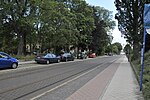
|
Bahnhofstrasse | Bahnhofstrasse (map) |
Today's Bahnhofstrasse was temporarily called "Hindenburgstrasse". The author does not know what it was called before the station was built in the mid-19th century. It connects the forecourt of Gotha train station with the outskirts of the old town. Since May 2, 1894, the tram tracks have run through this street. This street was with the mighty buildings of Gothaer Leben, Gothaer Feuer, Gothaer Allgemeine, Thüringer Elektrizitäts-Liefergesellschaft and three hotels (including the "Hotel Herzog Ernst", southeast corner of Stielerstrasse and Bahnhofstrasse), the "Hotel Alt" (today "Waldbahn-Hotel", southwest corner of Bebelstrasse and Bahnhofstrasse), today the boulevard of the city, through which its visitors, coming from the station, found the city. The photos are taken from the north end of the street at the corner of Parkallee. In the enlargement you can see the station reception building at the end. |
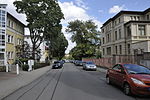
|
Helenenstrasse | Helenenstrasse (map) |
The street was named after Helene Meusel, b. Brückner, whose husband, MR Prof. Dr. Ernst Karl Eduard Meusel, who was an excellent eye surgeon. During the GDR era, the street bore the name of Friedrich Engels . |

|
Beautiful avenue | Schöne Allee (map) |
The street rightly bears its name. It was once called Lange Allee and Große Allee and was one of the most sought-after residential areas of the rich bourgeoisie. Among other things, the important economist and insurance scientist and writer, Arwed Emminghaus, lived here in a house that was built in 1898 by his friend, the architect and poet Bruno Eelbo . |
Individual features § 2 Paragraph (1) No. ThürDSchG
Sacred buildings
| image | address | Monument designation | comment |
|---|---|---|---|
 Location |
Neumarkt 13 | Evangelical parish church of St. Margarethen with artistic furnishings | |
 Location |
Klosterplatz | Evangelical parish church of the Augustinian monastery ( Augustinerkirche ) with artistic furnishings and former monastery buildings including monastery garden and enclosure | |
 Location |
Erfurt Landstrasse 31 | Evangelical Friedrichskirche (formerly Siechhofkirche) with artistic furnishings | Architect: Johann Erhard Straßburger , built in 1715 |
 Location |
Schelihastrasse 4 | Evangelical cruciform church with artistic furnishings | The Oberhofmeister and Real Privy Councilor and holder of the Grand Cross of the Electoral-Hessian Order of Lions, Ludwig Albert von Scheliha , was the Oberhofmeister of the Duchess Karoline Amalie von Hessen-Kassel (1771-1848), the wife of Duke August (1772-1822). Originally there was only a large garden area with a laundry drying area, where a gymnasium was built in the middle of the 19th century. In 1863 the first gymnasium was built for the Gothaer Turnverein founded in 1860. |
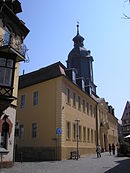 Location |
Bruehl 4 | Former hospital church ( Maria Magdalena Hospital ) with artistic furnishings | Architect: Johann Erhard Straßburger , built between 1716 and 1719 |
 Location |
Friedenstein Castle | Evangelical castle church with artistic furnishings in Friedenstein Castle | |
 Location |
Schützenallee 22 | Catholic parish church of St. Boniface with artistic furnishings |
Castle and parks, cemeteries
| image | address | Monument designation | comment |
|---|---|---|---|

|
Friedenstein Palace , park , tea castle , small architecture and monuments | ||

|
Friedrichstrasse 5 | Friedrichsthal Palace with gardens | |

|
Friedrichstrasse 6-8 | Orangery garden with buildings and fencing | |

|
Langensalzaer Strasse 98 | Main cemetery with crematorium and columbarium | |
| Eisenacher Strasse | Former West Cemetery ( Cemetery II ) | Location-> | |

|
Eisenacher Strasse / An der Klinge | Jewish Cemetery | Location-> |
Secular buildings (by streets)
(with subject to additions after May 2009)
18.-März-Strasse to Bahnhofstrasse
- 18.-März-Strasse: The street is named after the Kapp Putsch in Thuringia , when more than hundreds of Gotha residents lost their lives on March 18 and 19, 1920. It was called Kaiserstrasse from 1875 to 1946.
- Am Tivoli: The street is named after Tivoli , the name of the founding house of the Socialist Workers' Party Germany (SAP), the immediate predecessor of the SPD. Until 1871 the street was called “August-Blödner-Straße” after an industrialist from Gotha, in its continuation crossing Cosmarstraße to the spoonbill school “Roststraße” after Valentin Rost . The reason for the renaming was the 25th anniversary of the SED .
- Arnoldiplatz: The square is named after Ernst-Wilhelm Arnoldi , an important son of the city and "father of the German insurance industry". The square was formerly called "Erfurt Square".
- Augustinerstraße: The former "Große Sundhäuser Gasse" was renamed in 1889 after the Augustinerkirche located there .
- Bachstraße: The street is named after Johann Sebastian Bach . Originally it was called "Moltkestrasse" after the Prussian general Helmuth Karl Bernhard von Moltke .
- Bahnhofstrasse: The street was temporarily called "Hindenburgstrasse"; it connects the forecourt of Gotha train station with the outskirts of the old town. Since May 2, 1894, the tram tracks have run through this street. With the mighty buildings of Gothaer Leben, Gothaer Feuer, Gothaer Allgemeine, Thüringer Elektrizitäts-Liefergesellschaft and three hotels, this street was the boulevard of the city through which visitors coming from the train station found the city.
| image | address | Monument designation | comment |
|---|---|---|---|

|
March 18th Street 6 | Residential building | The neighboring house no. 8 was inhabited by Hermann Christ (1868–1948), the director of the Gotha fire insurance bank. |
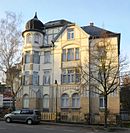
|
March 18th Street 7 | Residential building | |
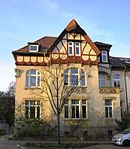
|
March 18th Street 9 | Residential house with enclosure | Built in 1904 by Richard Klepzig and Robert Kramer as "Villa Elise", together |

|
March 18th Street 11 | Residential house with enclosure | (House no.11 is only the right half of the house in the picture.) |

|
March 18th Street 15 | Residential house with enclosure | |

|
18 March Strasse 45 | Residential building | |
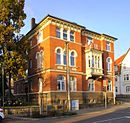
|
March 18th Street 51 | Residential building | |

|
At Tivoli 1a and 3 | Gasthaus with "Kaltwasserschem Saal" | |

|
At Tivoli 18 | Spoonbill School | |

|
Arnoldiplatz 1 | Residential building | |

|
Augustinerstrasse 15 | former office building, vacant | |

|
Augustinerstrasse 25 | Residential and commercial building | |
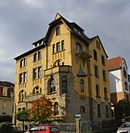
|
Bachstrasse 14 | House and enclosure | |

|
Bahnhofstrasse 2-4 | Erected as the administrative building for Gothaer Lebensversicherung . The building, built according to plans by court building officer Gustav Eberhard at a cost of 34,000 thalers, was ready for occupation in 1850. The head of administration lived on the top floor. An extension was added in 1868, and 10 years later the upper floor was also required for official purposes. The director now lived in the new building no. 2a connected to the bank. | |

|
Bahnhofstrasse 3a | Administration building (at that time for Gothaer Lebensversicherungsbank ). The plans of Arwed Emminghaus and of building officer Bruno Eelbo and the costs were approved on April 15, 1893. On November 1, 1894, the building was ready to move into. The costs, including the property, amounted to 696,000 marks. In 1817, Eelbo was asked to think about an extension. However, his ideas were not met; In addition, he died on November 17th of that year, so that an order was no longer possible. 1921/23 extension building (with a bent main axis in order to design the rear view of the building parallel to Mozartstrasse (at that time Ohrdrufer Strasse)) according to the design by Prof. Dr. German Bestelmeyer (house no.3b). Given the currency's strong purchasing power at the time, the extension cost 40,000 gold marks. From 1894 to 1946, the seat of Gotha life and non-fire insurance. | In addition to the German Insurance Museum, the building mainly houses the Thuringian Finance Court and the Gotha Social Court . |

|
Bahnhofstrasse 5a | Administration building, House III of the "Education Center of the Thuringian State Administration" (classrooms, library). Erected 1872–1874 for the “Deutsche Bodencreditbank”, owned by Gothaer Lebensversicherungsbank in 1934, which made it available to the subsidiary “Gothaer Allgemeine Versicherungsbank AG”. This in turn resided since its foundation in 1924 in the "kinked" extension of house no. 3a, with Kurt Jannott as "executive board member". | Erected 1872–1874 according to plans by the architect Ludwig Bohnstedt (1822–1885) |

|
Bahnhofstrasse 12 | Administration building, House I of the "Education Center of the Thuringian State Administration" (administration, lecture halls, administrative college), formerly the seat of the Gothaer Feuerversicherungsbank , before the building at Bahnhofstrasse 5a (in 1874) was completed as the new headquarters of the insurance company. |
Architect: Ludwig Bohnstedt (1822–1885) |
Bebelstrasse to Buttermarkt
- Bebelstrasse: The street is named after August Bebel , the socialist German politician and publicist. It used to be called "Rondellstraße" after a roundabout at the intersection with Bahnhofstraße and was called "Ludendorffstraße" after Erich Ludendorff , general and politician , during the Nazi era .
- Bergallee: The road leads uphill as a tree road to the castle.
- Berggartenweg: The road leads to the Berggarten excursion restaurant. The current building with a single family home dates back to the 1990s, after temporary homes for bomb-damaged people had been built in the allotment gardens on Berggartenweg in the 1940s.
- Bertha-von-Suttner-Straße: The street is named after Bertha von Suttner , the Austrian pacifist, peace researcher and writer, whose urn has a place of honor in the Gotha crematorium .
- Bohnstedtstraße: The street is named after Ludwig Bohnstedt , an important German architect who worked and died in Gotha. During the Nazi era it was called "Werderstrasse" after August von Werder , a Prussian general.
- Brühl: First mentioned in 1482. Brühl (from Middle Latin brogilus or broilus : piece of tree) means "damp lowland". Brühl is the name of many low-lying parts of the city, some of which are covered with trees, and streets that may have been built on former marshland, including the Gothaer Brühl. Here was the Holy Cross Gate, later renamed the Brühler Tor.
- Bürgeraue: The street, on a filled moat, is named after the former "Bürgeraue", the parade ground in front of the barracks on property no. 2.
- Butter market: Until 1869, the butchers' meat banks were located on the butter market . Each butcher had his own meat bank, a wooden stall. For hygienic reasons, the sale was stopped at this point, followed by the rural women, among other things with their butter range. When food was not being sold, other markets could also take place here, e.g. B. Pottery Markets.
| image | address | Monument designation | comment |
|---|---|---|---|

|
Bebelstrasse 10 | Administration building, House II of the "Education Center of the Thuringian State Administration" (teachers) | Built 1886–1888 and 1896 as the building of the former general agency of the fire insurance bank in Gotha. Architects: Erdmann und Spindler architects' office , Berlin |

|
Bergallee 8 | Ernestinum High School | |

|
Berggartenweg 50 | Excursion restaurant "Berggarten" | |

|
Bertha-von-Suttner-Strasse 1 | Residential building | |

|
Bertha-von-Suttner-Strasse 3 | Residential building | |

|
Bohnstedtstrasse 6 | Stadtbad | |

|
Bohnstedtstrasse 10 | Residential building | |

|
Bruehl 4 | Maria Magdalena Hospital with church | |
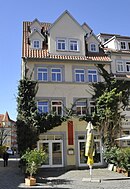
|
Bruehl 5 | Residential and commercial building | See also: Brühl (Gotha) . The drug and paint shop W. Hennig used to be here, as documented in a photo from 1910. |

|
Bruehl 7 | Residential and commercial building | Former Brewery "König-Sahl", (earlier spelling according to an old photograph: Königsaal) in which King Gustav II Adolf of Sweden is said to have stayed overnight on the night of 23/24 August 1632, according to the list of monuments from 1988. That The building is an old log house with the bay window in front of it. The restaurant used to be called "Zur Klause" and recently had a poor reputation. She closed in the 1960s. After that, the building and the building next to house number 5 fell into disrepair, so that it was partially demolished in January 1982. An emergency roof secured the remaining floor. Although reconstruction was planned during the GDR era, this did not take place due to lack of funds. It was only in 1996/97 that a private investor was able to carry out the construction plan, although apart from the facades, the remaining rooms and the vaulted cellar were sacrificed. See also: Brühl (Gotha) |

|
Bruehl 19 | Residential and commercial building | In this house there was the restaurant "Restauration zum Brühler Tor" from 1905, which only sold non-alcoholic drinks. The inn was owned by the health food company founded in 1904. |

|
Bürgeraue 2 | former barracks | Built: 1843–1845, architect: Hofbaumeister Gustav Eberhard , used by the military and police until the early 1980s, today a Kaufland branch |

|
Bürgeraue 10–12 | Double residential building | |

|
Bürgeraue 14 | Residential building | |

|
Bürgeraue 23 | Myconius School | |

|
Butter market 5 | Residential and commercial building | |

|
Butter market 6 | Residential and commercial building | Café Loesche was built in 1916 according to plans by Bruno Tamme . In 1914 there was a fire in the house behind it. At that time, it was home to the Loesche confectionery and the FA Kaempf grocery store (see Hauptmarkt 6–7). |
Dreikronengasse to Erfurter Straße
- Dreikronengasse: The name is reminiscent of the former restaurant "To the three crowns" (Bergallee 4, opposite Sundhäuser Gasse, today demolished.)
- Eisenacher Straße: Road towards Eisenach, once part of the Via Regia
- Ekhofplatz: The square was called Leninplatz from 1949 to 1991 and is now named after Conrad Ekhof , one of the best German actors of the 18th century. He died in Gotha.
- Emminghausstraße: The street is named after Arwed Emminghaus , a German economist and journalist who died in Gotha. However, Emminghaus lived in the "Emminghaus-Villa", Schöne Allee 2 (see there).
- Erfurter Landstrasse: The road was the arterial road to Erfurt and part of the B 7. Because of the hospital (road noise) and the Gotha-Bad Langensalza railway line (level crossing), it was closed as a thoroughfare to motor vehicle traffic.
- Erfurter Straße: Until 1887 "Große Erfurter Gasse", led to the Erfurter Tor, today the main shopping street.
| image | address | Monument designation | comment |
|---|---|---|---|
| No picture because this house number does not exist. | Dreikronengasse 1a | Residential building | This house number does not exist. |
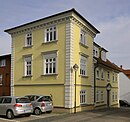
|
Dreikronengasse 10 | Residential building | There are three crowns painted on the wall above the front door of the house, named “Love”, “Faith” and “Hope”. |

|
Eisenacher Strasse 5 | Arnoldi school and gym | The art nouveau school built by Wilhelm Goette from 1909 to 1911 is named after the Gotha merchant Ernst-Wilhelm Arnoldi . |

|
Ekhofplatz 1 | Post office building | Built on the site of the administration building of the Gothaer Feuerversicherungsbank, built by Gustav Eberhard in 1841 , rebuilt in 1889 as the "Imperial Post Office". Also called "Stephans Inkwell" after Heinrich von Stephan (1831–1897), then General Post Director. The building originally had 3 domes, which were removed in 1938 as they no longer corresponded to contemporary tastes. |

|
Ekhofplatz 22 | former bank building ("Gothaer Privatbank") | Erected according to plans by Ludwig Bohnstedt (1873–1877) |

|
Emminghausstrasse 8 | District Office (formerly military hospital). | |

|
Emminghausstrasse 15 | Residential building with gate drive | |

|
Erfurt Landstrasse 35 | District hospital, houses 1, 2, 3, 4 and 11, entity | The houses cannot all be shown in one picture. After the opening of the Helios Clinic in Gotha-Sundhausen, the hospital and the affiliated pharmacy were closed. |

|
Erfurt Landstrasse 31 | Friedrichskirche , nursing home | Mentioned in the 13th century as Nicolai's Chapel, later part of the Leprosorum Hospital (leper courtyard, infirmary), new building in 1715, named after Duke Friedrich II. (1676–1732). Still used regularly as a church today. |

|
Erfurter Strasse 1 | Department store | Built in 1872 as "Hotel Wünscher". |

|
Erfurter Strasse 2 / Mönchelsstrasse 21a | In the 18th century a breeding, orphanage and insane asylum. Various authorities later moved here, such as the district court , in 1950 the people's police and the district council . | |
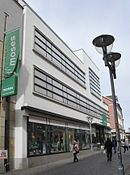
|
Erfurter Strasse 5/7 | Department store | Built in 1904 as the M. Conitzer & Sons fashion store based on plans by the architect Richard Klepzig , it was replaced in 1928 by a new and extension in the Bauhaus style, this time based on plans by the Gotha architect Bruno Tamme (1883–1964). See also: Coburg department store Conitzer with background information |

|
Erfurter Strasse 7 | Department store "M. Conitzer and Sons ”, Department Store Joh | Built in 1904 according to plans by Richard Klepzig, rebuilt in 1928 according to plans by Bruno Tamme in the Bauhaus style (only in the city center). |
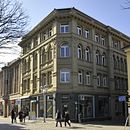
|
Erfurter Strasse 19 | Residential and commercial building, former commercial building of the Bonsack baker family | Architect: Julius Krusewitz , built at the end of the 19th century. |
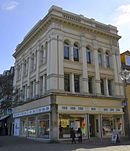
|
Erfurter Strasse 20 | Department store | "Feldmann-Kaufhaus", "Wasserbetthaus", architect: Julius Krusewitz , built at the end of the 19th century. |
Ernststrasse to Hansenstrasse
- Ernststrasse: The street has been named after Duke Ernst II , the city's great patron , since 1991 . It used to be part of Dr.-Hans-Loch-Strasse.
- Florschützstraße: The street has been named after Johann Christoph Florschütz (1794–1882), the teacher and long-time companion of Prince Albert of Saxe-Coburg and Gotha and his brother Prince Ernst , since 1939 .
- Friedrichstrasse: The street name honors the dukes Friedrich I, II and III, who helped determine the fate of the city from 1675 to 1772. During the GDR era it was called "Karl-Marx-Strasse".
- Friedrich-Perthes-Straße: The street is named after Friedrich Christoph Perthes , an important publisher and bookseller in Gotha.
- Gadollastraße: The street is named after Josef Ritter von Gadolla , who in 1945, by refusing to give orders, prevented the destruction by the Allies. Originally called "Kasernenstrasse".
- Galbergweg: The street is named after the Gal (gen) berg, a ridge of the Krahnberg , Gotha's local mountain .
- Gartenstrasse: Before 1969, this was a street with gardens and tall trees where the wealthy citizens wanted to build their villas. However, in the course of the widening because of the tram, only a few succeeded in doing this. The name was just a shell.
- Goethestrasse: Goethe visited Gotha several times.
- Goldbacher Straße: The street is named after Goldbach , a district of the municipality of Nessetal in the Gotha district, where the street leads directly.
- Gotthardstraße: The street is named after the patron saint of the city, St. Gotthard . The upper section (Friedrichstrasse-Kastanienallee) was part of the Kastanienallee according to the city map from 1859, the lower part (up to the Wilder Graben) was called “Grünes Gäßchen”.
- Hansenstrasse: The street is named after Peter Andreas Hansen , a director of the Seeberg observatory.
| image | address | Monument designation | comment |
|---|---|---|---|

|
Ernststrasse 1 | House and enclosure | |

|
Ernststrasse 5a | Residential house with enclosure | |

|
Ernststrasse 10 | Residential building | |

|
Ernststrasse 16 | Residential house with enclosure | |

|
Ernststrasse 18 | Residential house with enclosure | |

|
Florschützstrasse 10 | "Alte Sternwarte" restaurant, meridian and obelisk | |

|
Friedrichstrasse 1 | Residential house with enclosure | Built in 1904 by Richard Klepzig as a villa for Oskar Blödner |

|
Friedrichstrasse 2 | Winter Palace | |

|
Friedrichstrasse 4 | Residential building | |
| Friedrichstrasse 12 | Former Court pharmacy, only the portal still preserved | ||

|
Friedrichstrasse 14, Villa Kunreuther | Residential house with garden and enclosure | Villa of the Kunreuther family, a stumbling block in front of the house reminds of the kidnapping of Anna Marie Kunreuther and her sister Marie Louise in the Theresienstadt ghetto in September 1942. |

|
Friedrichstrasse 19, villa | Residential house with garden and enclosure | |

|
Friedrichstrasse 24 | Residential building | |
 
|
Friedrich-Perthes-Strasse 4 | Residential building | Built in 1903 by Richard Klepzig as a commercial building for the Perthes publishing house |

|
Gadollastrasse 7 | former officers' mess (today a retirement home) | |

|
Galbergweg 12 | Former Rohrbach observatory. Rohrbach had the 30 m high reinforced concrete tower built on his private property in 1905. The telescope was placed on its own column in the tower to avoid vibrations. | |
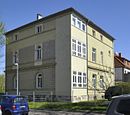 
|
Gartenstrasse 12 | Residential building (today district church office) | |
 
|
Gartenstrasse 28 | The building was erected in 1903 and was owned by the entrepreneur Otto Böhm and his wife Minna, b. Cupper, inhabited. The couple ran “Böhms Weinschenke” here. | From 1902 to 1987 you could dine in this restaurant. Today there is again a restaurant in the building. |
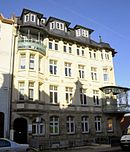
|
Goethestrasse 2 | Residential building | |

|
Goethestrasse 3, 5, 7 and 9 | Residential building | The houses at Goethestr. 3 to 9 form an architecturally uniform complex. |

|
Goldbacher Strasse 24a | Residential building | |
|
|
Goldbacher Strasse 33/35 | Shooting house and town hall | |

|
Gotthardstrasse 8 | School and kindergarten | |

|
Gotthardstrasse 9 | Former "Lang'sches Stiftungshaus" | Johann Wilhelm Lang was a bookbinder who married a daughter of the Hennicke family, a bookbindery, in Gotha. The company with its workshop was very successful. In 1893 he was able to provide the city of Gotha with 41,000 marks, which they should use, among other things, "for the establishment of a household and cooking school for poor girls". The school building of the "Lang Foundation" erected in 1897 also housed the city library that was created from another Lang Foundation. |

|
Gotthardstrasse 14 | gym | The building was erected in 1878. Today it houses the boxing club "Wacker Gotha eV". |

|
Hansenstrasse 7 | Residential building |
Main market
The square was not always called like this: in the past, the higher part was called “Holzmarkt”, the lower part “Jakobsplatz” because there was a Jacob's chapel here. The main market has always been the center of cultural, political and economic life. Until 1968 the tram also drove through the main market, through Marktstrasse and Erfurter Strasse to the train station.
| image | address | Monument designation | comment |
|---|---|---|---|

|
Hauptmarkt 1 | town hall | The building was built in 1574 as a department store for cloth , woad and grain traders . |

|
Hauptmarkt 2 | Guild hall | Previous building burned down in 1632, new building in 1633, reconstruction in Baroque style under Duke Friedrich II in 1715 , town hall until 1665, seat of the first German commercial school from 1820 to 1911, founded by Ernst-Wilhelm Arnoldi in 1817 , reconstruction of the ground floor by Julius Krusewitz in 1885 |
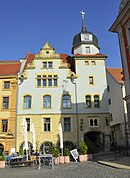 
|
Main market 3 | Ratskeller | Originally "Haus zum Ostrich", damaged by fire in 1632, new building in 1715, reconstruction by Wilhelm Goette (1873–1927) in 1907 |

|
Main market 4/5 | Residential and commercial building | |
 
|
Hauptmarkt 6 | Residential and commercial building | The complex of houses 6 and 7 is on the corner of Hauptmarkt and Hünersdorfstrasse. House no. 6 also had the name "Haus [illegible] (zum) Kautz". |
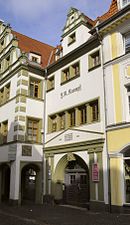
|
Hauptmarkt 7 | Residential and commercial building | The FA Kaempf grocery store and the Loesche confectionery were located in this building (at least until 1914). After a fire in 1914, the latter moved into the newly built Buttermarkt 6, where it is still located today. |
 
|
Hauptmarkt 8 | Residential and commercial building | The "House to the Lion Heads" has a house brand above the portal with a label "To the Lion Heads 1616". |
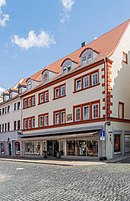  
|
Hauptmarkt 9 | Residential and commercial building, "Haus zur Weintraube" | Built in 1665 after the great city fire. The relief on the wall of the house (picture below) shows two mercenaries carrying a huge grape. At the corner of the house facing Gutenbergstrasse (middle picture) the Psalm 41 is attached in a baroque knot form: “Praise be to the Lord, the God of Israel from now on and forever. Amen. ”At that time this was understood as a request for protection against fire. In the left part of the building since 1874 a clothing store, in the right part until 1927 the elegant “Zum Riesen” inn. 1927 Conversion to today's appearance. |
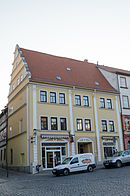
|
Hauptmarkt 10 | Residential and commercial building | The “House to the Red Horn” is Gotha's oldest pharmacy and was the first farm pharmacy. 1525 first mentioned as a spice merchant, on August 5, 1578 the pharmacist Matthias Doehnel received the "ducal privilegium exclusivum ". The house was owned by the Doehnels from 1553 to 1677. On the north side is a Renaissance gable and half-timbered extension from the 17th century. In 1949 the Hof-Apotheke was renamed the Goethe-Apotheke. |
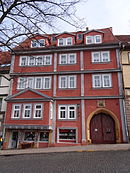 
|
Hauptmarkt 15 | House and side wing, house "To the two helmets" | House no. 15 has a portal from 1542. The city fires of the 17th century spared the building like few others. To the right above the portal is a hole in the wall in which a brewing symbol was put when there was freshly brewed beer (see also Schlossberg 10). In the neighboring house no. 14 ("Haus zum Roten Hirsch", not a designated cultural monument): Ernst Wilhelm Arnoldi lived here from 1823 until his death on May 27, 1841 and founded the first German life insurance company here in 1827, "Life Insurance Bank for Germany" . The painter, graphic artist and writer Kurt W. Streubel , who was born in Starkstadt in 1921 and died in Weimar in 2002 , also lived here from 1963 to 2000 . |
 
|
Hauptmarkt 17 | Residential building | In the previous building of this house, which fell victim to the town fire in 1632, the Gotha councilor Jobst Brengbier, Lucas Cranach the Elder's first father-in-law, lived. It later became the home of Cranach's daughter Ursula, who married Georg Dasch in 1544. In the double coat of arms (see picture) we find the winged snake (Cranach) and the bag (Dasch). The current building was built on older parts of the building at the beginning of the 18th century. From 1852 to 1986 it served as a school building. In the Gothic cellar of the house there is a pumping station of Wasserkunst am Schlossberg (so to speak right in front of the door) with a turbine from Gothaer Maschinenfabrik Briegleb & Hansen from 1895. |
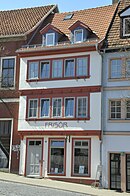
|
Hauptmarkt 19 | Residential and commercial building | |

|
Hauptmarkt 25 | Residential and commercial building, rear building (not shown) | |
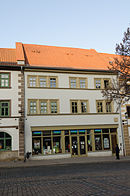
|
Hauptmarkt 27 | Residential and commercial building | |

|
Main market 28 | Residential and commercial building | |
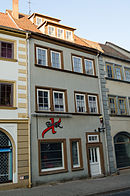
|
Hauptmarkt 29 | Part of the window frames 1st and 2nd floor | |

|
Hauptmarkt 30 | Residential and commercial building | |
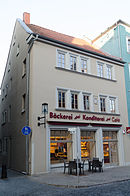
|
Main market 31 | Residential and commercial building | |

|
Main market 32 | Waidhaus rear building (not shown) | |
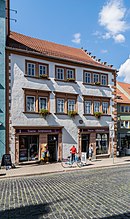
|
Main Market 33 | Residential and commercial building | |
 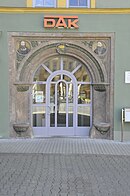
|
Hauptmarkt 34 | Residential and commercial building | House "Zur Güldenen Krone": The house with the Renaissance portal was the residence of the secret council director Johann Friedrich Bachoff von Echt . From 1803 to 1875 it served as a post office. During this time from 1817 to 1867 as a post office of Thurn und Taxis . |

|
Main market 35 | Residential and commercial building | |
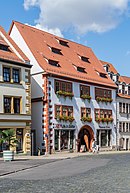
|
Main market 36 | Residential and commercial building, Waidhaus | |
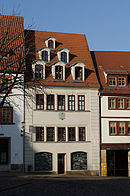
|
Hauptmarkt 37 | Residential and commercial building, house "Zur güldenen Quelle" | Birthplace of Ernst-Wilhelm Arnoldi |
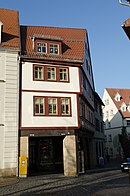 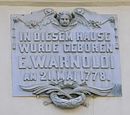
|
Hauptmarkt 38 | Residential and commercial building | |

|
Hauptmarkt 39 | Residential and commercial building | |
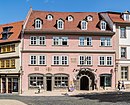
|
Hauptmarkt 40 | Residential and commercial building, extension on the courtyard side | The "House of the Golden Bell" was built in 1599. Originally an inn for relaxation with horse stables. Goethe stayed here with his Christiane. In 1870 the Emanuel and Abraham Ruppel families moved from Stadtlengsfeld to Gotha and opened the “Gebrüder Ruppel” hardware store in this house. They later founded the Ruppelwerke in Reinhardsbrunner Str. 57–59. |
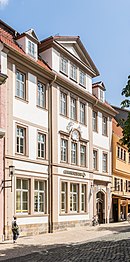
|
Hauptmarkt 41 | Residential and commercial building | Former "House of the Silver Bell" |

|
Hauptmarkt 42 | Residential and commercial building (left 42, right 43) | House “Zur Löwenburg”: Martin Luther stayed in this house on his journey from Schmalkalden to Weimar from February 27th to March 4th. He was the guest of the magistrate Johann Lebe in the "Löwenburg" named after him. Seriously ill, Luther wrote his first testament here and designated Gotha as his burial place. However, after recovering, he was able to continue his journey. |

|
Hauptmarkt 43 | Residential and commercial building | |
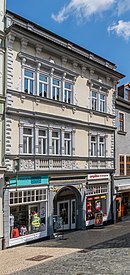 
|
Hauptmarkt 45 | Residential and commercial building, Waidhaus | "House of the golden stars", see inscription above the portal. Here, the business of was Bertha Schneyer (1830-1912) who founded the city a large sum of money and land. |
Heinestrasse to Justus-Perthes-Strasse
- Heinestrasse: named after the poet prince Heinrich Heine (1797–1856). Before 1945 "Bismarckstrasse".
- Helenenstraße: The street was named after Helene Meusel, b. Brückner, whose husband was an excellent eye surgeon.
- Hohe Straße: Possibly a section of the alta strada from Frankfurt to Leipzig.
- Hünersdorfstraße: The street is named after Karl Heinrich Hünersdorf , a local politician and Lord Mayor of Gotha. The reason for the naming was the couple's golden wedding anniversary on September 4, 1894. Until 1869 it was called Fleischgasse as the street leading to the meat market (today the butter market). Until the end of the 19th century, the butchers' stalls, the "meat banks", stood on the butter market.
- Jägerstrasse: The ducal Oberlandjägermeisterei was located in Jägerstrasse.
- Jüdenstrasse: Even in the Middle Ages, Jews were only allowed to live in certain streets, probably also here on Jüdenstrasse. After 1933 the street was called Dietrich-Eckart-Straße , after 1945 Waidstraße.
- Justus-Perthes-Straße: The street is named after Justus Perthes , the German bookseller and publisher in Gotha.
| image | address | Monument designation | comment |
|---|---|---|---|

|
Heinestrasse 1 | Residential building | |

|
Helenenstrasse 4 | court House | From 1964 to 1989 the district office of the Ministry for State Security of the GDR, the so-called "StaSi", was located here. On December 4, 1989, courageous Gotha citizens of the Gotha Citizens' Committee occupied the house. |

|
Helenenstrasse 5 | Residential building | |
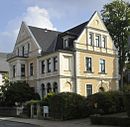
|
Helenenstrasse 8 | House and enclosure | |

|
Helenenstrasse 16 | Residential building | |
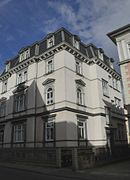
|
Hohe Strasse 11 | House and enclosure | |

|
Hohe Strasse 38 | House and enclosure | |

|
Hünersdorfstrasse 1 | Residential building | |

|
Hünersdorfstrasse 7 | Residential and commercial building | |

|
Hünersdorfstrasse 8 | Part of the shop zone | |

|
Hünersdorfstrasse 10 | Residential and commercial building | |

|
Hünersdorfstrasse 16 | Part of the shop zone | |

|
Jaegerstrasse | Transformer house | |

|
Jägerstrasse 7 | former observatory | |

|
Jüdenstrasse 11 | Residential building | |
 
|
Justus-Perthes-Strasse 2 | District Court | |

|
Justus-Perthes-Strasse 2a | Enclosed school | The building was designed and built in 1908 by the Gotha architect Alfred Cramer . For this building he was awarded the Knight's Cross 2nd class of the Ducal Saxon-Ernestine House Order. The stone building rests on an E-shaped floor plan. The main building encloses an inner courtyard. The upper floors of the main building are summarized by pilasters and capitals . The street-side facade is emphasized by a three-axis risalit with the coat of arms of the Dukes of Gotha crowned by acroteries . The appearance corresponds to the architectural style of the neo-renaissance . |

|
Justus-Perthes-Straße 3–9 Former Justus Perthes publishing house (from 2010 “Perthes-Forum”), whole |
Built in 1856; Expanded and rebuilt several times until 2014, today Klett-Perthes-Forum | The former publishing complex was rebuilt from 2012 to 2014 and serves as a new central depot and archive building for extensive holdings of the Schloss Friedenstein Foundation , the Thuringian State Archives Gotha and the Gotha Research Library (including the Perthes Gotha Collection ). |

|
Justus-Perthes-Strasse 11 | Residential and commercial building | Built in 1886 |
Karl-Schwarz-Strasse to Mariengasse
- Karl-Schwarz-Straße: The street is named after the theologian Karl Schwarz , who worked in Gotha, among other places. It used to be called "Kleine Brühler Straße", after the layout of cemetery III "Friedhofstraße".
- Kastanienallee: A street lined with chestnut trees, even today.
- Kesselmühlenweg: The street is named after the listed, former Kessel (born) mill, at the separation between Mühlgraben and Wilder Graben, see Kesselmühle
- Liebetraustraße: The street is named after Otto Liebetrau , a Gotha local politician and Lord Mayor. Before “Reichsstraße”, now “Fritz-Heilmann-Straße” .
- Lindenauallee: The street is named after Bernhard von Lindenau , an astronomer at the Seeberg observatory.
- Lucas-Cranach-Straße: The street is named after Lucas Cranach the Elder. who lived in the previous building of the house on the corner of Hauptmarkt (Hauptmarkt 17). Until 1888 it was called "Kleine Siebleber Gasse".
- Lutherstrasse: The street was named in honor of the reformer Martin Luther , who visited Gotha four times. The formerly narrow alley Lutherstrasse was created as a result of the new buildings of the Sparkasse as a wide driveway and breakthrough from Neumarkt to Gartenstrasse at the turn of the century 1899/1900. At the southern end of Lutherstrasse, Gerbergasse branches off to NE, under which part of the Leinakanal runs, which has been covered with slabs since 1855 and which today runs in pipes. In 1950 the small tanner's houses stood in the narrow alley.
- Margarethenstraße: The street owes its name to the neighboring church of St. Margarethen .
- Mariengasse: The street was named after Duchess Marie , the wife of Duke Ernst I of Saxe-Coburg and Gotha and founder of the children's sanatorium "Marienpflege" (Mariengasse 1).
| image | address | Monument designation | comment |
|---|---|---|---|

|
Karl-Schwarz-Strasse 2 | Residential building | |

|
Kastanienallee 8 | Residential building | Medical center, formerly "Haus Fischer". |

|
Kesselmühlenweg | Bridge over flood ditch | |

|
Kesselmühlenweg 4 | Kettle mill, entity | |

|
Leina Canal | with structures | |
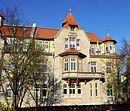
|
Liebetraustraße 20 | Residential building | |

|
Lindenauallee 28 | Residential building | |

|
Lucas-Cranach-Strasse 3 | Residential building | |
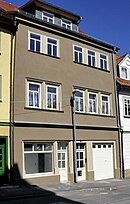
|
Lucas-Cranach-Strasse 7 | Residential building | |

|
Lucas-Cranach-Strasse 9 | House and side building | Residence of Baron Silvius Friedrich Ludwig von Frankenberg (1728–1815), Privy Councilor and Minister of three Dukes of Gotha-Sachsen-Altenburg from 1765 until his death. The house was built in 1712. As a minister in Weimar, Goethe also stayed here. |

|
Lucas-Cranach-Strasse 9a | Frankenberg's garden house | |

|
Lucas-Cranach-Strasse 11 | Residential and commercial building | |

|
Lutherstrasse 2 | Savings bank | 1905–1906 built in Art Nouveau style by the Berlin architects Erdmann und Spindler as the new main building for the "Sparkasse für das Duchy Gotha" founded in 1830. |

|
Lutherstrasse 4-6 | Residential and commercial building, KSK Gotha | Architect: Julius Krusewitz , built in 1903 |
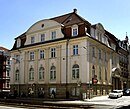
|
Lutherstrasse 8 | AOK building | |

|
Margarethenstrasse 2-4 | Spoonbill House | |

|
Margarethenstrasse 9 | Residential building | |

|
Mariengasse 4 | former summer house |
Marktstrasse to Mönchelsstrasse
- Marktstrasse: It bears its name because it connects the main market with the Neumarkt and is a street for traders. Originally it was called "Kleine Erfurter Gasse" as a counterpart to "Große Erfurter Gasse", today's Erfurter Straße.
- Mohrenstrasse: The street name refers to the former “Zum Mohren” inn, which was the most distinguished and largest in Gotha. Until 1897 the road to Erfurt ran from the main market via Marktstraße, Neumarkt, Erfurter Straße, Mohrenberg, past the "Mohren", via Friemarer Straße to "Hohen Sand", Mauerstraße, Schlichtenstraße, Seebergstraße, Erfurter Landstraße to Siebleben ( Weimarer Straße) (today's street names).
- Mönchelsstrasse: The origin of the name of the street has not been clearly established. Possibly derived from Henricius Mennichen , a resident councilor. Perhaps the monks of St. Maragarethen also lived here. Or both ...
| image | address | Monument designation | comment |
|---|---|---|---|
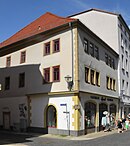
|
Marktstrasse 1 | Residential and commercial building | |

|
Marktstrasse 4 | Facade part | |

|
Marktstrasse 5 | Residential and commercial building | |

|
Marktstrasse 6 | Residential and commercial building | |

|
Marktstrasse 7 | Residential and commercial building | |

|
Marktstrasse 9 | Residential and commercial building | |
 
|
Marktstrasse 11 | Residential and commercial building, rear building (Waidhaus) | Here was the grocery store founded in 1893 by Otto Böhm , who had acquired the house in 1906 from the heirs of master dyer Julius Piesbergen. However, he had the old building demolished as early as 1907 and commissioned the Gotha architect Alfred Cramer to plan a new residential and commercial building. The new building was already finished in 1908. Between the windows of the first floor is the high relief of the three-masted cog "Hansa", the family symbol. A consumer outlet was located here from 1951 to 1991 . |

|
Marktstrasse 12 | Residential and commercial building | |
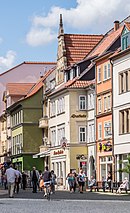
|
Marktstrasse 13 | Residential and commercial building, courtyard with side building | |
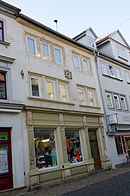
|
Marktstrasse 18 | Residential and commercial building | |

|
Marktstrasse 20 | Residential and commercial building | This building, like the houses at Marktstrasse 11 and Gartenstrasse 28, also belonged to the entrepreneur Otto Böhm . |
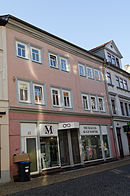
|
Marktstrasse 22 | Residential and commercial building, | |

|
Marktstrasse 24 | Residential and commercial building, | |

|
Marktstrasse 26 | Residential and commercial building | |

|
Mohrenstrasse 27a | Residential building | |

|
Mönchelsstrasse 21 | Residential building | |

|
Mönchelsstrasse 21a | Administration building | |

|
Mönchelsstrasse 22 | Residential and commercial building | |

|
Mönchelsstrasse 34 | Residential building |
Mozartstraße to Puschkinallee
- Mozartstraße: Wolfgang Amadeus Mozart is the namesake of the street, which before 1933 led to part of the Ohrdrufer Straße. From 1933 to 1945 it was called Hermann-Göring-Straße .
- Mühlgrabenweg: In 1708 the Mühlgraben was created as a Ratsrinne branch for flood protection. The section that runs parallel to the road at a distance of 50 m is, however, the “Wilde Graben”; the Mühlgraben begins south of the viaduct, operated the boiler mill and merges into the Wilder Graben at the level of Brückenstrasse.
- Myconiusplatz: The street is named after Friedrich Myconius , friend of Luther and superintendent, who did a great job for the Reformation in the Gotha area and the local school system.
- Neumarkt: The Neumarkt was created by expanding the market square and splitting it into a new and an old market (main market).
- Parkallee: The Parkallee leads along the castle park between the museum and the rose garden. Until 1950 it was called Schloßallee, today's Puschkinallee was until then the Schloßallee extension called Parkallee.
- Pestalozzi-Strasse: so named in honor of the pedagogue Johann Heinrich Pestalozzi .
- Pfarrgasse: The Pfarrgasse formed the connection between the Margarethenkirche and the official residence of the pastor.
- Pfortenstraße: As a "gate lane" it led to a small gate in the city wall. All the houses on Pfortengasse burned down in 1667.
- Puschkinallee: so named in honor of the Russian poet Alexander Sergejewitsch Pushkin . Until 1950 it was called Parkallee, today's Parkallee Schloßallee.
| image | address | Monument designation | comment |
|---|---|---|---|

|
Mozartstrasse 1 | Cavalier's House at the Prinzenpalais | |

|
Mozartstrasse 1 | Prince's Palace | |

|
Mozartstrasse 4 | Residential building; formerly owned by Gothaer Leben | |

|
Mozartstrasse 5 | ||

|
Mozartstrasse 17 | Reyher school and gym | |

|
Mozartstrasse 18 | Apartment block (with Bebelstrasse 2 and 4) | |

|
Mozartstrasse 19 | Ackerbürgerhof, northeast stable and barn building, currently small apartments | |
 
|
Mozartstrasse 34 | Residential building | |

|
Mühlgrabenweg 15 | "Spohrhaus" | The house is named after Louis Spohr , Gotha concertmaster and wife of Dorette Spohr since 1806 . He lived here from 1808 to 1813. The house has been empty for a few years and is in dire need of renovation. The simple commemorative plaque with the text Louis Spohr lived here that was once attached to the street has disappeared. |

|
Myconiusplatz 1 | House and wall (probably part of the city wall) | The “ Sundhäuser Tor ” once stood here , a western exit from the old town in the direction of Eisenach. |

|
Myconiusplatz 2 | Superintendent | |

|
Neumarkt 1 | Residential and commercial building | |
 
|
Neumarkt 6 | Residential and commercial building, “Zum Schrapfen” building, a station until the middle of the 19th century with overnight accommodation for the moving mail. Around 1900 the seat of the Strupp bank. | |

|
Neumarkt 26 | Residential and commercial building | The house is the birthplace of Dorette Spohr , b. Scheidler, an important harp player in her time. From 1806 to 1808 her husband Louis Spohr lived here , according to Nicolò Paganini "the greatest singer on the violin", who then lived with her in the "Spohr-Haus", Mühlgrabenweg 15, until 1813. |
 
|
Park avenue 1 | Former stables, built in 1848 using Seeberg sandstone according to plans by the architect Gustav Eberhard (1805–1880) . The main entrance of the north wing on Parkallee has a round arched portal with a Saxon diamond wreath coat of arms. Until 1997 the riding arena and the stables were used for equestrian sports. In 1998 extensive renovations were carried out to create apartments, offices and a gallery. This was done with financial support from the state of Thuringia. | |
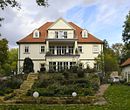
|
Park avenue 13 | Residential building | House Adam Weishaupt , founder of the Illuminati , residence from 1786 until his death. |
 
|
Park avenue 15 | Ducal Museum Gotha | Upper picture: north side Lower picture: south side |

|
Pestalozzistraße 2 | former school | |

|
Pestalozzistraße 4 | former retirement and nursing home " Oskar Blödner " | |

|
Pfarrgasse 1 | Residential building | |

|
Pfortenstrasse 1 | Shop zone and lettering | |

|
Puschkinallee 2 | Residential building | Built in 1904 by Richard Klepzig as a villa for Leopold Möller |
| No picture, no. 2a does not exist | Puschkinallee 2a | gym | This house number does not exist |
Cross street to Reinhardsbrunner Straße
- Cross street: The street runs across the other old town streets, which have an east-west orientation. Because it was the first street in the old town to be paved so that it would not be swept away onto the Neumarkt when it rained because of its slope, it was formerly known as the “Steinerne Gasse”.
- Reinhardsbrunner Straße: The road leads via Sundhausen and Wahlwinkel to Reinhardsbrunn Castle . During the Nazi era it was named after Willy Marschner , a functionary of that time.
| image | address | Monument designation | comment |
|---|---|---|---|
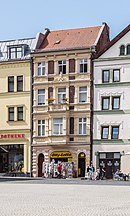
|
Cross street 2 | Residential and commercial building | |

|
Cross street 4 | Residential and commercial building | |

|
Cross street 10 | Residential and commercial building | |

|
Cross street 14 | Residential building | |

|
Cross street 16 | Residential and commercial building | |
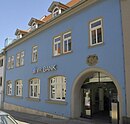 
|
Cross street 17 | Commercial building | Lower picture: House brand above the entrance portal. Extensive excavations and restoration work in the basement. |
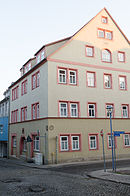
|
Cross street 21 | Residential and commercial building | According to an inscription in the gable from 1668; Franckehaus , built by Johannes Francke . Marriage coat of arms of Johannes (Hans) Francke (1625–1670), court and judiciary for Duke Ernst the Pious of Saxe-Gotha-Altenburg, and Anna Gloxin (1635–1709), daughter of Lübeck's mayor David Gloxin (1597–1671). These are the parents of the theologian August Hermann Francke (1663–1727). Inscription stone with Psalm 40 verse 12. |
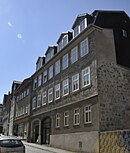
|
Cross street 24 | Four-sided courtyard with residential building | |

|
Reinhardsbrunner Strasse 10 | Residential building | |
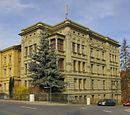
|
Reinhardsbrunner Strasse 14/18. March Street | House and enclosure | Architect: Julius Krusewitz , built in 1898 |
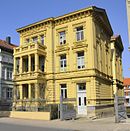
|
Reinhardsbrunner Strasse 16 | Residential building | |

|
Reinhardsbrunner Strasse 17 | Residential building | |

|
Reinhardsbrunner Strasse 19 | Herzog-Ernst-Schule, formerly the seat of the Herzog-Ernst-Seminar, a school for teachers, which was founded in 1780 on the initiative of the orphanage pastor Johann Christian Haun. | Architect: Julius Krusewitz , built in 1888 |

|
Reinhardsbrunner Strasse 23 | District Office building | |

|
Reinhardsbrunner Strasse 26 | House and enclosure | |

|
Reinhardsbrunner Strasse 31 | House and enclosure | |

|
Reinhardsbrunner Strasse 35 | House and enclosure | |

|
Reinhardsbrunner Strasse 42 | Residential building |
Schäferstrasse to Seebachstrasse
- Schäferstraße: The street is named after the postmaster Friedrich August Schäfer (1796–1880), the founder of the Schäferstiftung, among others.
- Schlossberg: A steep uphill street from the main market to the castle.
- Schöne Allee: The street rightly bears its name. It was once called Lange Allee and Große Allee and was one of the most sought-after residential areas of the rich bourgeoisie.
- Schützenallee: until 1824 Große Brühler Straße, then renamed Schützenallee in honor of the Gothaer Schützen.
- Schützenberg: Until 1823 Brühlstraße, then renamed Schützenberg in honor of the Gothaer Schützen. It leads steeply uphill to Schützenplatz by the town hall.
- Schwabhäuser Strasse: The namesake of this street, first mentioned in 1405, could be the Lords of Schwabhausen , but also a senator and a councilor of the 14th century. It's unclear.
- Seebachstrasse: So named in 1874 in honor of the deserving Minister Camillo von Seebach .
| image | address | Monument designation | comment |
|---|---|---|---|

|
Schäferstrasse 10 | Shepherd School, former Shepherd Foundation | In the will of the postmaster Friedrich August Schäfer (1796-1880) it was decreed that a “home for disabled men” should be built from his funds. The “Schäferstift” was built in 1894 as a men's retirement home based on plans by Bruno Eelbo and today functions as the “Big Palais children's and youth center”. |

|
Schäferstrasse 47 | Residential building | |

|
Schlossberg 2 | former "landscape house" | The house was formerly the "Western Hagensche Palais", the palace of General von Westernhagen . It was built around 1600 and renewed in its current form around 1700. From 1641 to 1848 this was the seat of the representatives of the estates, then until 1920 the seat of the state parliament, then the seat of various authorities. From 1931 until the end of the war, the Thuringian Bacteriological Research Institute was housed here, and the Hygiene Institute from 1945 to 1991. The building underwent renovations in 1957 and 1975, currently (2015) another renovation behind concealed painted tarpaulins is in progress. In 2008, the city's own construction company bought the house from the state of Thuringia. |

|
Schlossberg 4 | Residential building | The early Baroque half-timbered building was built in 1672 as a residential and commercial building on top of a medieval predecessor, the vaulted cellar of which is still there. From 1821 to 1945 (!) There was a tailor's shop on the ground floor. The house was extensively renovated in 1995. |

|
Schlossberg 8 | Residential building | On the ground floor, the Schlossgasse leads to the Nonnenberg (lower picture). |

|
Schlossberg 10 | Residential building | House "Zum Fürsten-huthe" (F-House) : In the keystone of the portal there is an "F" with the year 1711 and a bishop's cap. From the observer to the left there is a hole with a decorated border: A brewing symbol was inserted here when there was freshly brewed beer (see also Hauptmarkt 15). The house was built as a Freihof in 1703 and acquired in 1828 by Baron von Wangenheim , presumably Karl August von Wangenheim (1773–1850). After 1900 the owners changed several times. |

|
Schlossberg 12/14 | Administration building | The so-called "Paradies" office building, named after the relief "Paradiessteine" (today in Engelsbach ), was the seat of the Gotha bailiff from the 16th century to 1619 . In the 18th century, Gotha ministers and court officials lived here. From 1826 to 1858 the property was the administrative seat, from 1858 to 1923 the district office and then the seat of various offices. On the ground floor there is a plank room from the mid-16th century. |
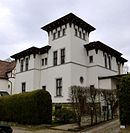
|
Beautiful avenue 2 | Residential building | The "Emminghaus Villa": Villa of the important economist and insurance scientist and writer, Arwed Emminghaus . The house was built in 1898 by the architect and poet friend Bruno Eelbo . |

|
Schöne Allee 9 (a) | Residential building | |

|
Schützenallee 10 | Therese Gayer Foundation: Donated by Christiane Therese Gayer (1819–1896) for single unmarried women of the bourgeoisie and converted in 1899 as a retirement home for 20 women. 1962 expanded again for 58 people. In 1992 the after-work home was incorporated into the “Städtische Heime Gotha GmbH”. | |

|
Schützenallee 12 | Villa Friedrichs: House built in 1907 on behalf of the brickworks owner Robert Friedrichs (1849–1924), today connected to the neighboring house No. 12 by an intermediate building. | |
 
|
Schützenallee 29 + 31 | House 31: Luther school, built in 1876 for the secondary school. House 29: former gymnasium |
|

|
Schützenberg 23 | former farmyard | |

|
Schwabhäuser Strasse 24 | Gasthaus Brauhof | In 1908 the school principal Karl Kohlstock moved here with his “New German Recreation Home” from Brühl 19. |

|
Seebachstrasse 11 | Residential house with enclosure | Villa built by Richard Klepzig in 1899 for Fritz Bothmann (called "Carousel Chapel") |
Siebleber Strasse to Waschgasse
- Siebleber Straße: The street, first mentioned in 1414 and called "Große Siebleber Gasse" until 1888, once led to the Siebleber Tor in the city wall, where it still ends today at Ekhofplatz.
- Siebleber Wall: Name of a city fortification there, once also called "Kleiner Schloßberg".
- Spohrstraße: The street is named after the composer and concert master Louis Spohr , who did not live here, however, but at Neumarkt 26 and Mühlgrabenweg 15 (“Spohr-Haus”).
- Südstraße: The street is in the south of the city. It used to be called "Kohlstrasse" and "Kohlenstrasse" after the cabbage gardens located there. During the Nazi era it was given the name "Saarstrasse".
- Sundhäuser Gasse: The alley led to the Sundhäuser Gate in the west of the old town. Until 1889 it was called "Kleine Sundhäuser Gasse".
- Trützschlerplatz: named after Wilhelm Adolph von Trützschler , a German politician born in Gotha. From 1938 the square was called Langemarckplatz .
- Uelleber Straße: The road leads to Uelleben , a Gotha suburb.
- Waltershäuserstraße: The street was built after 1863 and leads to Waltershausen . During the Nazi era it was called Fritz-Sauckel- Strasse.
- Waschgasse: The wash house of Friedenstein Castle was located here. Today the Waschgasse is a steep staircase from the old town (extension of the cross street) into the castle park.
| image | address | Monument designation | comment |
|---|---|---|---|

|
Siebleber Strasse 7 | House and side building | |

|
Siebleber Strasse 8 | Residence, "House of Castel Sant'Angelo" | In 1787 Adam Weishaupt's apartment , founder of the Illuminati Order (not clarified), until 1817 Thurn und Taxis post office. Carl Bechstein's birthplace . Pauline von Schelling's death house . Until 1904, this was the prayer room of the Israelite religious community. Since 1951 community center of the Evangelical Free Church Community. On November 11, 2016, a memorial plaque was placed on the house. |
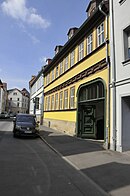
|
Siebleber Strasse 9 | House and side building | |
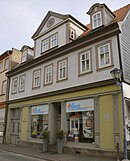
|
Siebleber Strasse 12 | Residential and commercial building | Erected around 1780 as an arable bourgeois house, the upper floor and roof with superstructures in baroque appearance are still preserved. 1866 apartment of court dentist Dr. Meister, furniture shop owned by master joiner Louis Lux in 1895. Ground floor facade based on plans by Julius Krusewitz , extensive renovation in 1993 |

|
Siebleber Strasse 14 | Courtyard | |

|
Siebleber Strasse 24 | Facade part | Was a listed city palace from the 18th century, with an early classical facade, demolished in 2011. It served u. a. the noble families von Wangenheim and von Bassewitz as residence. |
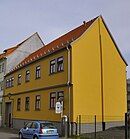
|
Siebleber Strasse 26 | House and side building | |
| No picture, building has been torn down. | Siebleber Strasse 29 | Rear building (warehouse) | Building demolished |

|
Siebleber Strasse 33 | House and side building | |
| No picture, the hall no longer exists. | Siebleber Wall 9 | Exhibition hall | The property Siebleber Wall 7-9 was once the old mint in Gotha and has been owned by von Wangenheim (Karl August von Wangenheim) since 1821 . Despite promising plans for further use after the fall of the Wall, the building complex was demolished in 1997 due to its disrepair and a residential complex was built in its place. |

|
Spohrstrasse 7 | House and enclosure | |

|
Spohrstrasse 11 | House and enclosure | |

|
Südstrasse 2-2a | High bunker | Angle tower on the site of the former Reichsbahn repair shop (switch factory). The bunker also served as an air raid shelter. |

|
Sundhäuser Gasse 2/4 | Residential and commercial building | There is no house number 4. |
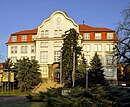
|
Trützschlerplatz 1 | State college for construction, economics and transport Gotha | |
 
|
Uelleber Strasse 3a | former slaughterhouse, aggregate | The slaughterhouse was built in the years 1890-1892 by the architect Conrad Schaller . The slaughterhouse existed until 1990, and since 1994 the building complex has been a multifunctional "Schlosspark-Center" with many shops and service providers. |

|
Uelleber Strasse 18 | Residential and commercial building | |

|
Waltershäuser Strasse 1/3 | Duplex house | In 1896, the architect Julius Krusewitz built an office and residential building for the manufacturer Philipp Harjes on the property at number 1 . |

|
Waltershauser Strasse 48 | Residential building | |

|
Waltershauser Strasse 52 | Duplex house | |

|
Waltershauser Strasse 54 | Duplex house | |

|
Waltershäuser Strasse 60 / 60a | Residential building | |

|
Wash alley | Staircase |
Boilstädt
Seven lives
| image | address | Monument designation | comment |
|---|---|---|---|
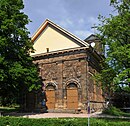
|
Evangelical parish church “St. Helena ”with artistic furnishings, churchyard and enclosure | ||

|
Former Mönchhof Castle with parks and ponds | ||
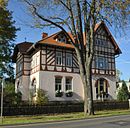
|
Mönchallee 14 | Residential house with coach house and garden | |

|
Oberstrasse 9 | Residential house with barn | |

|
Weimarer Strasse 138 | former school | |
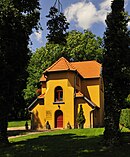
|
Weimarer Strasse 145 | "Haus zur gute Schmiede", home of Gustav Freytag (1816–1895) and Sylvius Friedrich von Frankenberg and Ludwigsdorff (1728–1815) | (The building shown is the former garden pavilion of the residential building. A current photo of the residential building will be delivered shortly.) |
Sundhausen
| image | address | Monument designation | comment |
|---|---|---|---|

|
Evangelical parish church “St. Nikolai ” with artistic furnishings, churchyard and enclosure | Architect: Johann Erhard Straßburger , built in 1729/30 | |
 
|
Pfarrstrasse 5 | Rectory with rectory garden and two barns | |

|
Pfarrstrasse 8 | former Siedelhof | Four-sided courtyard, of which the two south-facing sides were added later as (unsightly) brick buildings. |
Potty life
| image | address | Monument designation | comment |
|---|---|---|---|

|
Evangelical Luther Chapel with artistic furnishings, churchyard and enclosure |
Life
| image | address | Monument designation | comment |
|---|---|---|---|

|
Evangelical parish church “St. Johannes “with artistic furnishings, churchyard and enclosure | ||

|
Boilstädter Strasse 2 | former manor house with farm buildings (manor) |
Soil monuments
| image | designation | location | Dating | description | ID |
|---|---|---|---|---|---|
| Burial mound | District Gotha, hall 34, parcel 33, hall 35, parcel 677/20 Auf dem Seeberg (map) |
|
|||
 |
Schwedenschanze | District Gotha, corridor 26/6, parcel 355 (map) |
Wooded rectangular ramparts with rounded corners on the western Krahnberg, on Frankfurter and Eisenacher Strasse ( Via Regia ); According to local lore, it was built by the Swedes during the Thirty Years' War. |
|
|
 |
Wayside shrine | District Gotha, hall 19, parcel 434 (map) |
Wayside shrine with empty niches on three sides, fourth side unprocessed. |
|
|
| Burial mound | District Gotha, corridor 36, parcel 1070 (map) |
|
|||
 |
Stone cross | District Gotha, hall 21, parcel 45/40 Gotha, Am Steinkreuz (Mittelhausen settlement), on a rear garden fence. (Map) |
Latin cross carved from sandstone, without major damage. |
|
|
 |
Burial mounds, court mounds | District Gotha, hall 28, parcel 64, 64/9002 Near the Kindleber Straße at the junction to Bufleben. (Map) |
Oval, wooded hill on the northeast side of the small settlement Kindleben. Is also interpreted as the temporary location of a control room or tower hill castle. |
|
|
 |
Wayside shrine | District Gotha, hall 37, parcel 221 (Siebleben, Riedgasse, at the end of the paved route) (map) |
Wayside shrine with 1 empty niche |
|
See also
Literature and Sources
- Hans Walther: Street Chronicle of the City of Gotha , Rockstuhl Publishing House, Bad Langensalza, ISBN 3-934748-26-0
Web links
- List of monuments of the city of Gotha, status 2009 (PDF; 3.1 MB)


